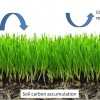 Native and improved pastures play an important role in sequestering carbon from the atmosphere. Because of the relatively high sequestration rates and extensive area, grazing land represents an important component of terrestrial carbon dioxide (CO2) offset and is a significant sink for long-term carbon sequestration and greenhouse gas mitigation. This 4-page fact sheet contains information for stakeholders, students, scientists, and environmental agencies interested in enhancing ecosystems services provided by grazing lands. Written by Maria Silveira, Ed Hanlon, Mariana Azenha, and Hiran M. da Silva, and published by the UF Department of Soil and Water Science, September 2012.
Native and improved pastures play an important role in sequestering carbon from the atmosphere. Because of the relatively high sequestration rates and extensive area, grazing land represents an important component of terrestrial carbon dioxide (CO2) offset and is a significant sink for long-term carbon sequestration and greenhouse gas mitigation. This 4-page fact sheet contains information for stakeholders, students, scientists, and environmental agencies interested in enhancing ecosystems services provided by grazing lands. Written by Maria Silveira, Ed Hanlon, Mariana Azenha, and Hiran M. da Silva, and published by the UF Department of Soil and Water Science, September 2012.
http://edis.ifas.ufl.edu/ss574
Category: Environment
Black-tailed Mosquito Culiseta melanura (Coquillett) (Insecta: Diptera: Culicidae) (EENY536/IN950)
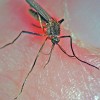 The black-tailed mosquito is unusual because it overwinters as larvae while most mosquito species overwinter as either adults or eggs. Culiseta melanura is important because of its role in the transmission cycle of eastern equine encephalitis virus and potentially West Nile virus: because adult female Culiseta melanura primarily take their blood meals from birds, they are responsible for transmitting eastern equine encephalitis virus between birds. This 6-page fact sheet was written by Eva Buckner, Angelique Showman, and C. Roxanne Connelly, and published by the UF Department of Entomology and Nematology, September 2012.
The black-tailed mosquito is unusual because it overwinters as larvae while most mosquito species overwinter as either adults or eggs. Culiseta melanura is important because of its role in the transmission cycle of eastern equine encephalitis virus and potentially West Nile virus: because adult female Culiseta melanura primarily take their blood meals from birds, they are responsible for transmitting eastern equine encephalitis virus between birds. This 6-page fact sheet was written by Eva Buckner, Angelique Showman, and C. Roxanne Connelly, and published by the UF Department of Entomology and Nematology, September 2012.
http://edis.ifas.ufl.edu/in950
Florida Scorpionfly, Panorpa floridana Byers (Insecta: Mecoptera: Panorpidae) (EENY538/IN949)
 Have you seen this insect? No living individuals of Panorpa floridana ever have been observed. Knowledge of this species of scorpionfly is limited to five specimens from Alachua and Clay counties in northern peninsular Florida, the last one collected in 1982. This 4-page fact sheet was written by Louis A. Somma and James C. Dunford, and published by the UF Department of Entomology and Nematology, September 2012.
Have you seen this insect? No living individuals of Panorpa floridana ever have been observed. Knowledge of this species of scorpionfly is limited to five specimens from Alachua and Clay counties in northern peninsular Florida, the last one collected in 1982. This 4-page fact sheet was written by Louis A. Somma and James C. Dunford, and published by the UF Department of Entomology and Nematology, September 2012.
http://edis.ifas.ufl.edu/in949
Spring Viremia of Carp (VM142/VM106)
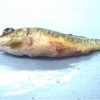 Spring viremia of carp is a viral disease that can cause significant mortality in several carp species including the common carp. It was reported in koi and feral carp in the United States for the first time in 2002. Diagnosis in farm raised fish in the U.S. may result in quarantine of the infected fish and depopulation. This 5-page fact sheet is intended to inform veterinarians, biologists, culturists, and hobbyists about Spring viremia of carp. Written by Barbara D. Petty, Ruth Francis-Floyd, and Roy P.E. Yanong, and published by the UF Department of Fisheries and Aquatic Sciences, August 2012.
Spring viremia of carp is a viral disease that can cause significant mortality in several carp species including the common carp. It was reported in koi and feral carp in the United States for the first time in 2002. Diagnosis in farm raised fish in the U.S. may result in quarantine of the infected fish and depopulation. This 5-page fact sheet is intended to inform veterinarians, biologists, culturists, and hobbyists about Spring viremia of carp. Written by Barbara D. Petty, Ruth Francis-Floyd, and Roy P.E. Yanong, and published by the UF Department of Fisheries and Aquatic Sciences, August 2012.
http://edis.ifas.ufl.edu/vm106
Cactus Moth, Cactoblastis cactorum (Berg) (Insecta: Lepidoptera: Pyralidae) (EENY056/IN213)
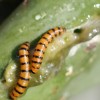 Since its arrival in the Florida Keys in 1989, this invasive species has become a serious threat to the diversity and abundance of Opuntia cactus in North America. The spread of this moth raises concerns about harm to rare opuntioid species (prickly pear and related cacti), the endangerment of wild opuntioids in the southwestern United States and Mexico and the consequent effects on entire desert ecosystems and economic hardship for communities in Mexico that cultivate and sell Opuntia. This 5-page fact sheet was written by D. H. Habeck, F. D. Bennett, and Christine Miller, and published by the UF Department of Entomology and Nematology, September 2012.
Since its arrival in the Florida Keys in 1989, this invasive species has become a serious threat to the diversity and abundance of Opuntia cactus in North America. The spread of this moth raises concerns about harm to rare opuntioid species (prickly pear and related cacti), the endangerment of wild opuntioids in the southwestern United States and Mexico and the consequent effects on entire desert ecosystems and economic hardship for communities in Mexico that cultivate and sell Opuntia. This 5-page fact sheet was written by D. H. Habeck, F. D. Bennett, and Christine Miller, and published by the UF Department of Entomology and Nematology, September 2012.
http://edis.ifas.ufl.edu/in213
Earthworm, suborder Crassiclitellata, cohort Terrimegadrili (Jamieson, 1988) (EENY532/IN946)
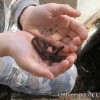 Like insects, earthworms are among the animals most frequently encountered by many Floridians. Our kids play with them, dissect them in middle school biology, we fish with them, they crawl across our sidewalks and live in our flower pots. Despite this, their ecological and economic importance often goes unrecognized. Earthworms have several important ecological roles. Additionally, some species are used commercially for bait, animal feed, environmental remediation, and composting. This 6-page fact sheet was written by William T. Crow, and published by the UF Department of Entomology and Nematology, September 2012.
Like insects, earthworms are among the animals most frequently encountered by many Floridians. Our kids play with them, dissect them in middle school biology, we fish with them, they crawl across our sidewalks and live in our flower pots. Despite this, their ecological and economic importance often goes unrecognized. Earthworms have several important ecological roles. Additionally, some species are used commercially for bait, animal feed, environmental remediation, and composting. This 6-page fact sheet was written by William T. Crow, and published by the UF Department of Entomology and Nematology, September 2012.
http://edis.ifas.ufl.edu/in946
An Asian Ground Beetle, Mochtherus tetraspilotus (MacLeay) (Coleoptera: Carabidae: Lebiini) (EENY533/IN951)
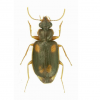 Mochtherus tetraspilotus (MacLeay) was first detected in southern Florida in 1992. Since then specimens have been collected in Gainesville and at Archbold Biological Station in Highlands County. Adult members of this group of Carabidae are known to be predators. The impact of this species on our native species remains to be determined, as does the source of introduction. Its rapid spread in Florida suggests that it may soon be found throughout the Gulf States. This 2-page fact sheet was written by Paul M. Choate, and published by the UF Department of Entomology and Nematology, September 2012.
Mochtherus tetraspilotus (MacLeay) was first detected in southern Florida in 1992. Since then specimens have been collected in Gainesville and at Archbold Biological Station in Highlands County. Adult members of this group of Carabidae are known to be predators. The impact of this species on our native species remains to be determined, as does the source of introduction. Its rapid spread in Florida suggests that it may soon be found throughout the Gulf States. This 2-page fact sheet was written by Paul M. Choate, and published by the UF Department of Entomology and Nematology, September 2012.
http://edis.ifas.ufl.edu/in951
Guidelines and Management Practices for Artificial Reef Siting, Use, Construction, and Anchoring in Southeast Florida (TP176/SG101)
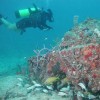 Coral reefs are one of southeast Florida’s most highly valued ocean resources. Despite their economic and ecological importance, they continue to face damage and destruction from human activity. “Artificial reefs” can help restore damaged coral reefs or mitigate their loss. Hundreds these natural and man-made structures have been deployed in southeast Florida coastal waters over the last 30 years. However, construction practices, design features and use patterns associated with this reef-building all have the potential to affect coral ecosystems. This 162-page guide describes artificial reef science and technology as a means of helping practitioners with varied backgrounds, skills and experience achieve responsible and sustainable reef development. Written by William Lindberg and William Seaman, and published by the UF Florida Sea Grant Program, June 2012.
Coral reefs are one of southeast Florida’s most highly valued ocean resources. Despite their economic and ecological importance, they continue to face damage and destruction from human activity. “Artificial reefs” can help restore damaged coral reefs or mitigate their loss. Hundreds these natural and man-made structures have been deployed in southeast Florida coastal waters over the last 30 years. However, construction practices, design features and use patterns associated with this reef-building all have the potential to affect coral ecosystems. This 162-page guide describes artificial reef science and technology as a means of helping practitioners with varied backgrounds, skills and experience achieve responsible and sustainable reef development. Written by William Lindberg and William Seaman, and published by the UF Florida Sea Grant Program, June 2012.
http://edis.ifas.ufl.edu/sg101
Polyphemus Moth Antheraea polyphemus (Cramer) (Insecta: Lepidoptera: Saturniidae: Saturniinae) (EENY531/IN945)
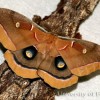 The polyphemus moth, Antheraea polyphemus (Cramer), is one of our largest and most beautiful silk moths. It is named after Polyphemus, the giant cyclops from Greek mythology who had a single large, round eye in the middle of his forehead. The name is because of the large eyespots in the middle of the moth’s hind wings. This 9-page fact sheet was written by Donald W. Hall, and published by the UF Department of Entomology and Nematology, August 2012.
The polyphemus moth, Antheraea polyphemus (Cramer), is one of our largest and most beautiful silk moths. It is named after Polyphemus, the giant cyclops from Greek mythology who had a single large, round eye in the middle of his forehead. The name is because of the large eyespots in the middle of the moth’s hind wings. This 9-page fact sheet was written by Donald W. Hall, and published by the UF Department of Entomology and Nematology, August 2012.
http://edis.ifas.ufl.edu/in945
Agricultural Management Options for Climate Variability and Change: High-Residue Cover Crops (AE488)
 While decision making in agriculture involves many aspects beyond climate, including economics, social factors, and policy considerations, climate-related risks are a primary source of yield and income variability. This 4-page fact sheet focuses on the use of high-biomass winter cover crops to improve production systems. Written by Joel Love, Jed Dillard, Kirk Brock, Daniel Dourte, and Clyde Fraisse, and published by the UF Department of Agricultural and Biological Engineering, August 2012.
While decision making in agriculture involves many aspects beyond climate, including economics, social factors, and policy considerations, climate-related risks are a primary source of yield and income variability. This 4-page fact sheet focuses on the use of high-biomass winter cover crops to improve production systems. Written by Joel Love, Jed Dillard, Kirk Brock, Daniel Dourte, and Clyde Fraisse, and published by the UF Department of Agricultural and Biological Engineering, August 2012.
http://edis.ifas.ufl.edu/ae488
Conservation Subdivision: Post-construction Phase – Urban Trees Can Reduce Household Carbon Footprint (WEC321/UW366)
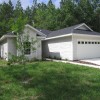 During the post-construction phase, the conservation and planting of native trees in individual yards and open spaces can reduce household and neighborhood carbon footprints. This 5-page fact sheet discusses the importance of urban trees and their role in mitigating for climate change by avoiding carbon emissions and removing carbon dioxide from the atmosphere. Written by Richard Vaughn, Mark Hostetler, and Francisco Escobedo, and published by the UF Department of Wildlife Ecology and Conservation, June 2012.
During the post-construction phase, the conservation and planting of native trees in individual yards and open spaces can reduce household and neighborhood carbon footprints. This 5-page fact sheet discusses the importance of urban trees and their role in mitigating for climate change by avoiding carbon emissions and removing carbon dioxide from the atmosphere. Written by Richard Vaughn, Mark Hostetler, and Francisco Escobedo, and published by the UF Department of Wildlife Ecology and Conservation, June 2012.
http://edis.ifas.ufl.edu/uw366
Common Monogenean Parasites of Fishes (FA28/FA033)
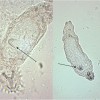 Monogeneans are a class of parasitic flatworms that are commonly found on fishes and lower aquatic invertebrates. Most monogeneans are browsers that move about freely on the fish’s body surface feeding on mucus and epithelial cells of the skin and gills; however, a few adult monogeneans will remain permanently attached to a single site on the host. Some monogenean species invade the rectal cavity, ureter, body cavity, and even the blood vascular system. Between 4,000 and 5,000 species of monogeneans have been described. They are found on fishes in fresh and salt water and in a wide range of water temperatures. This 10-page fact sheet was written by Peggy Reed, Ruth Francis-Floyd, and RuthEllen Klinger, and published by the UF Department of Fisheries and Aquatic Sciences, June 2012.
Monogeneans are a class of parasitic flatworms that are commonly found on fishes and lower aquatic invertebrates. Most monogeneans are browsers that move about freely on the fish’s body surface feeding on mucus and epithelial cells of the skin and gills; however, a few adult monogeneans will remain permanently attached to a single site on the host. Some monogenean species invade the rectal cavity, ureter, body cavity, and even the blood vascular system. Between 4,000 and 5,000 species of monogeneans have been described. They are found on fishes in fresh and salt water and in a wide range of water temperatures. This 10-page fact sheet was written by Peggy Reed, Ruth Francis-Floyd, and RuthEllen Klinger, and published by the UF Department of Fisheries and Aquatic Sciences, June 2012.
http://edis.ifas.ufl.edu/fa033
Entomopathogenic Nematodes (Nematoda: Rhabditida: families Steinernematidae and Heterorhabditidae) (EENY530/IN944)
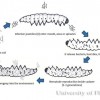 Entomopathogenic nematodes are soft bodied, non-segmented roundworms that are obligate or sometimes facultative parasites of insects. They occur naturally in soil environments and locate their host in response to carbon dioxide, vibration, and other chemical cues. They fit nicely into integrated pest management programs because they are nontoxic to humans, specific to their target pests, and can be applied with standard pesticide equipment. This 4-page fact sheet was written by Nastaran Tofangsazie, Steven P. Arthurs, and Robin M. Giblin-Davis, and published by the UF Department of Entomology and Nematology, August 2012.
Entomopathogenic nematodes are soft bodied, non-segmented roundworms that are obligate or sometimes facultative parasites of insects. They occur naturally in soil environments and locate their host in response to carbon dioxide, vibration, and other chemical cues. They fit nicely into integrated pest management programs because they are nontoxic to humans, specific to their target pests, and can be applied with standard pesticide equipment. This 4-page fact sheet was written by Nastaran Tofangsazie, Steven P. Arthurs, and Robin M. Giblin-Davis, and published by the UF Department of Entomology and Nematology, August 2012.
http://edis.ifas.ufl.edu/in944
Agricultural Management Options for Climate Variability and Change: Sod-Based Rotation (AE492)
 A sod-based rotation is when a producer adapts a conventional peanut/cotton rotation by growing a perennial grass, such as bahiagrass, during two years of the rotation. The perennial grass can be grazed, cut for hay or harvested for seed for additional income. Using a sod-based rotation can improve soil water-holding capacity and potentially reduce impacts of dry spells and droughts. This 4-page fact sheet was written by David Wright, Jim Marois, Clyde Fraisse, and Daniel Dourte, and published by the UF Department of Agricultural and Biological Engineering, August 2012. http://edis.ifas.ufl.edu/ae492
A sod-based rotation is when a producer adapts a conventional peanut/cotton rotation by growing a perennial grass, such as bahiagrass, during two years of the rotation. The perennial grass can be grazed, cut for hay or harvested for seed for additional income. Using a sod-based rotation can improve soil water-holding capacity and potentially reduce impacts of dry spells and droughts. This 4-page fact sheet was written by David Wright, Jim Marois, Clyde Fraisse, and Daniel Dourte, and published by the UF Department of Agricultural and Biological Engineering, August 2012. http://edis.ifas.ufl.edu/ae492
Agricultural Management Options for Climate Variability and Change: AgroClimate (AE491)
 AgroClimate is a website providing climate information and decision-support tools to producers throughout the Southeastern United States. With information from the site, producers can develop a strategy for the coming season and track climate conditions that affect crop development and yield. This 4-page fact sheet was written by Clyde Fraisse, and published by the UF Department of Agricultural and Biological Engineering, August 2012. http://edis.ifas.ufl.edu/ae491
AgroClimate is a website providing climate information and decision-support tools to producers throughout the Southeastern United States. With information from the site, producers can develop a strategy for the coming season and track climate conditions that affect crop development and yield. This 4-page fact sheet was written by Clyde Fraisse, and published by the UF Department of Agricultural and Biological Engineering, August 2012. http://edis.ifas.ufl.edu/ae491
Phosphorus Fertilizer Recommendations for Sugarcane Production on Florida Organic Soils (SSAGR348/SC091)
 Much of the sugarcane grown in South Florida is on organic soils in the Everglades Agricultural Area, which is a phosphorus-limited system. Phosphorus loads in drainage water in the Everglades Agricultural Area are an environmental concern so it is important for sugarcane growers to use best management practices such as soil testing and to follow fertilizer recommendations. This document contains updated UF/IFAS phosphorus fertilizer recommendations for Florida organic soils. This 7-page fact sheet was written by J. Mabry McCray, Ronald W. Rice, and Alan L. Wright, and published by the UF Department of Agronomy, July 2012. http://edis.ifas.ufl.edu/sc091
Much of the sugarcane grown in South Florida is on organic soils in the Everglades Agricultural Area, which is a phosphorus-limited system. Phosphorus loads in drainage water in the Everglades Agricultural Area are an environmental concern so it is important for sugarcane growers to use best management practices such as soil testing and to follow fertilizer recommendations. This document contains updated UF/IFAS phosphorus fertilizer recommendations for Florida organic soils. This 7-page fact sheet was written by J. Mabry McCray, Ronald W. Rice, and Alan L. Wright, and published by the UF Department of Agronomy, July 2012. http://edis.ifas.ufl.edu/sc091
Cottonwood Leaf Beetle Chrysomela scripta Fabricius (Insecta: Coleoptera: Chrysomelidae: Chrysomela) (EENY519/IN936)
 The cottonwood leaf beetle is one of the most economically-important pests of managed cottonwood, aspen, and some poplar and willow species. Often it is a severe pest of urban ornamental trees. This leaf feeder has several generations each year, may cause extensive leaf loss, and can consequently reduce stem volume up to 70%. This 6-page fact sheet was written by Amelio A. Chi and Russell F. Mizell III, and published by the UF Department of Entomology and Nematology, June 2012.
The cottonwood leaf beetle is one of the most economically-important pests of managed cottonwood, aspen, and some poplar and willow species. Often it is a severe pest of urban ornamental trees. This leaf feeder has several generations each year, may cause extensive leaf loss, and can consequently reduce stem volume up to 70%. This 6-page fact sheet was written by Amelio A. Chi and Russell F. Mizell III, and published by the UF Department of Entomology and Nematology, June 2012.
http://edis.ifas.ufl.edu/in936
Rethinking the Role of Nitrogen and Phosphorus in the Eutrophication of Aquatic Ecosystems (SGEF190/SG118)
 For many years, environmental agencies have sought to improve the water quality of lakes and estuaries by reducing inputs of phosphorus. New research indicates that we must reduce both phosphorus and nitrogen to reverse eutrophication symptoms. This 3-page fact sheet was written by Karl Havens and Thomas Frazer, and published by the UF Department of Sea Grant, June 2012.
For many years, environmental agencies have sought to improve the water quality of lakes and estuaries by reducing inputs of phosphorus. New research indicates that we must reduce both phosphorus and nitrogen to reverse eutrophication symptoms. This 3-page fact sheet was written by Karl Havens and Thomas Frazer, and published by the UF Department of Sea Grant, June 2012.
http://edis.ifas.ufl.edu/sg118
Embalses Costeros Para el Control de los Mosquitos (ENY648S/IN193)
 Los embalses costeros utilizados en Florida para el control de los mosquitos son marismas o manglares con un dique periférico que permite inundar el área durante la temporada de cría de mosquitos. Desde entonces, investigaciones científicas han demostrado que el embalsamiento puede causar serios impactos ambientales en las marismas, manglares y esteros colindantes. Hoy en día, se ha devuelto una hidrología más natural a más de 1,300 ha de marismas y manglares embalsados y se han eliminado más de 70 km de diques. De las 16,185 ha originales de marismas embalsadas en la laguna Indian River, se han restaurado de alguna manera más de 12,600 ha, ya sea por reconexión, brechas en los diques, o restauración de las orillas. This 6-page fact sheet was written by Jorge R. Rey y C. Roxanne Connelly, and published by the UF Department of Entomology and Nematology, June 2012.
Los embalses costeros utilizados en Florida para el control de los mosquitos son marismas o manglares con un dique periférico que permite inundar el área durante la temporada de cría de mosquitos. Desde entonces, investigaciones científicas han demostrado que el embalsamiento puede causar serios impactos ambientales en las marismas, manglares y esteros colindantes. Hoy en día, se ha devuelto una hidrología más natural a más de 1,300 ha de marismas y manglares embalsados y se han eliminado más de 70 km de diques. De las 16,185 ha originales de marismas embalsadas en la laguna Indian River, se han restaurado de alguna manera más de 12,600 ha, ya sea por reconexión, brechas en los diques, o restauración de las orillas. This 6-page fact sheet was written by Jorge R. Rey y C. Roxanne Connelly, and published by the UF Department of Entomology and Nematology, June 2012.
http://edis.ifas.ufl.edu/in193
Mosquito Control Impoundments (ENY648S/IN192)
 A mosquito control impoundment is a salt marsh or mangrove forest with an earthen dike around the perimeter that allows the area to be artificially flooded during the mosquito breeding season. Since the seventies, research has shown that impounding can have severe environmental impacts on the marshes and the adjoining estuary. So, over 12,600 hectares of the original 16,185 of impoundments have been rehabilitated in some fashion. This 6-page fact sheet was written by Jorge R. Rey and C. Roxanne Connelly, and published by the UF Department of Entomology and Nematology, June 2012.
A mosquito control impoundment is a salt marsh or mangrove forest with an earthen dike around the perimeter that allows the area to be artificially flooded during the mosquito breeding season. Since the seventies, research has shown that impounding can have severe environmental impacts on the marshes and the adjoining estuary. So, over 12,600 hectares of the original 16,185 of impoundments have been rehabilitated in some fashion. This 6-page fact sheet was written by Jorge R. Rey and C. Roxanne Connelly, and published by the UF Department of Entomology and Nematology, June 2012.
http://edis.ifas.ufl.edu/in192